The fantasy of ‘One Piece’ becomes real on Netflix
The best-selling manga in history, written by Eiichiro Oda, is now a series with an eclectic group of protagonists
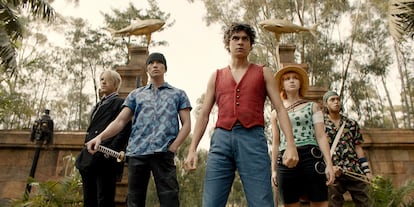
The enthusiastic Monkey D. Luffy has a dream: to become the Pirate King. Accompanied by his peculiar crew, he will sail the seas in search of the One Piece, a legendary treasure. With his inseparable straw hat, his rubber-like body and his companions, he will face various dangers, from abominable monsters to other pirates with similar ambitions, as well as the marines who try to enforce the law.
The fantasy and adventure universe of One Piece dates back to 1997, when the first issue of Japanese Eiichiro Oda’s work was published. Today, this adventure with pirates with superpowers comprises 105 volumes, of which more than 516 million copies have been sold in 61 countries. One Piece is the best-selling manga in history. An anime with more than 1,000 episodes, 15 animated films and several video games are further proof of its enormous popularity. Now, the One Piece universe has broken a new barrier with the premiere of its live-action series adaptation on Netflix.
Getting to this point was not an easy task. As Eiichiro Oda himself explained, this adaptation, created in collaboration with the Shueisha publishing company and produced by Tomorrow Studios and Netflix, was first conceived seven years ago. The eight episodes of its first season took six months to film in South Africa and, once filming was completed, Oda asked to reshoot numerous scenes because he did not think they met expectations. Not everything was worthy of the universe to which the writer has devoted so many years.
The author — also executive producer of the series — warns the followers of his stories that, being a live-action series, many elements had to be adapted and adjusted. What does not change (at his express request) are the background stories of the members of the Straw Hat crew — those plots about their origins are featured prominently in this first season — as well as the powers and abilities that the demon fruit grants whoever eats it, which range from having a rubbery, elastic body, to being able to split into multiple parts and recompose at will.
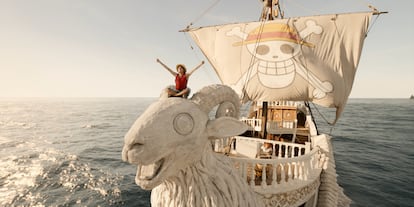
Netflix’s version of One Piece is not only for the fans of the manga and the anime: its intention is also to win over those who did not know about its existence before. The actors who play the crew of the Going Merry ship, an eclectic quintet composed of Mexican Iñaki Godoy (Luffy), Japanese Mackenyu (Zoro), Jamaican Jacob Romero (Usopp), American Emily Rudd (Nami) and Spanish-British Taz Skylar (Sanji), spoke about it to EL PAÍS; the interview took place in mid-June in São Paulo, weeks before the actors’ strike prevented the series and movies from being promoted by their protagonists.
“It’s a comforting, feel-good series,” said Emily Rudd. “It’s impossible to watch it and not feel like you can do anything that comes into your head. It is a series about found family, where we all encourage each other to follow our dreams and be the best that we can be,” the actress continues. “There aren’t many things on television that give you that aspirational boost. That’s what I hope we bring to people,” adds Taz Skylar. “But nothing we do can come close to how perfect the One Piece manga and anime already are. We just give it a new flavor, a new color. Let’s hope that we bring One Piece to people who had not heard about it before,” adds Jacob Romero.
For Iñaki Godoy, the optimistic and brave Monkey D. Luffy, the biggest challenge when approaching his character was finding the balance between Luffy’s energy and the realism that the series demanded. “In Mexican culture, we like to celebrate and take care of our family. That influenced my life growing up, and also my role,” reflects the 20-year-old actor. For Jacob Romero, dealing with characters that are so well-established in the imagination of millions of people was a great challenge. “They have a lot of history, and it would have been easy to try to recreate what we already know. But I think we also had to add to them what we are ourselves.”
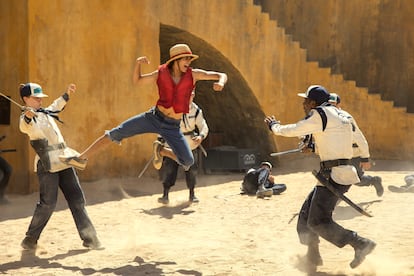
Taz Skylar highlights the physical work. “Getting my body to act the way I needed to physically perform everything my character had to do was a physically painful process. And we had to adhere to that painful process for almost a year, for 10 to 12 hours a day,” says the actor, getting serious amid the playful atmosphere that prevailed during the interview. Training was also basic in Mackenyu’s case. His character, Zoro, is an expert swordsman who is capable of wielding up to three swords at a time. “I was used to handling up to two swords,” explains the actor, who already had martial arts training. “But the third one… we had to train a lot with specialists; it was fun and challenging at the same time.” The stunt coordinator of the series and a master swordsman helped him choreograph his moves for the fight sequences.
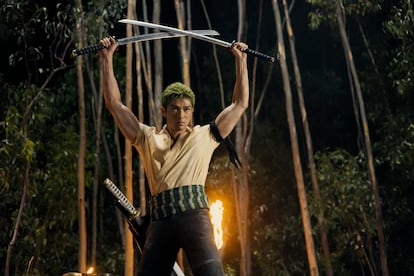
In addition to the mandatory visual and digital effects, Matt Owens and Steven Maeda, the developers of the series, wanted the world of One Piece to be as tangible and real as possible, for which they set out to reproduce the locations and places that appear in the comics. In the case of the ships, they reused many ships that had been built for the pirate series Black Sails, which ended in 2017 (a large part of the team that worked on that Starz production now works in One Piece). However, two ships were built from scratch: the Going Merry (the first ship of the Straw Hats) and the Baratie, the one with the fish-head figurehead and whose hull is inspired by a Spanish galleon. The actors highlight precisely these two locations and the detail and thoroughness of their recreation. “We had incredible locations that helped create a deeply magical world that is very faithful to the original, but at the same time very fresh and real,” says Emily Rudd. “There were even things that the camera was never going to show, but that we saw. Things behind doors, labels on cans… things you would never see, but they were there,” adds Taz Skylar.
The day this interview took place, the actors had already had their first big public appearance in front of the fans at Tudum, an event organized by Netflix in São Paulo in June where the names of the series and the characters were chanted by thousands of people. Are they prepared for all the good and the bad that comes with the fan phenomenon? “I don’t really know if we have to think about that. I can’t wait for people to watch the series, especially people who aren’t already fans of One Piece,” says Emily Rudd, and Jacob Romero adds: “Besides, we know that we have each other.” Just like the Straw Hat crew.
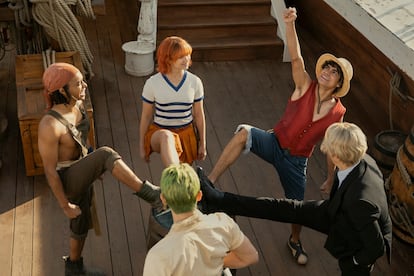
Sign up for our weekly newsletter to get more English-language news coverage from EL PAÍS USA Edition
Tu suscripción se está usando en otro dispositivo
¿Quieres añadir otro usuario a tu suscripción?
Si continúas leyendo en este dispositivo, no se podrá leer en el otro.
FlechaTu suscripción se está usando en otro dispositivo y solo puedes acceder a EL PAÍS desde un dispositivo a la vez.
Si quieres compartir tu cuenta, cambia tu suscripción a la modalidad Premium, así podrás añadir otro usuario. Cada uno accederá con su propia cuenta de email, lo que os permitirá personalizar vuestra experiencia en EL PAÍS.
¿Tienes una suscripción de empresa? Accede aquí para contratar más cuentas.
En el caso de no saber quién está usando tu cuenta, te recomendamos cambiar tu contraseña aquí.
Si decides continuar compartiendo tu cuenta, este mensaje se mostrará en tu dispositivo y en el de la otra persona que está usando tu cuenta de forma indefinida, afectando a tu experiencia de lectura. Puedes consultar aquí los términos y condiciones de la suscripción digital.
More information
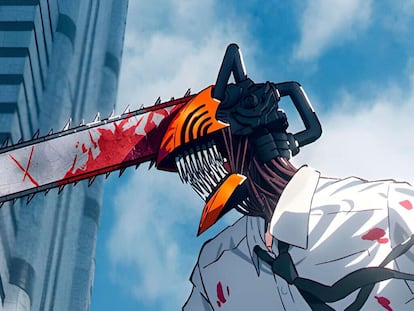
Six series to discover the world of Japanese anime
Archived In
Últimas noticias
Most viewed
- Reinhard Genzel, Nobel laureate in physics: ‘One-minute videos will never give you the truth’
- Oona Chaplin: ‘I told James Cameron that I was living in a treehouse and starting a permaculture project with a friend’
- Pablo Escobar’s hippos: A serious environmental problem, 40 years on
- Chevy Chase, the beloved comedian who was a monster off camera: ‘Not everyone hated him, just the people who’ve worked with him’
- Why we lost the habit of sleeping in two segments and how that changed our sense of time










































